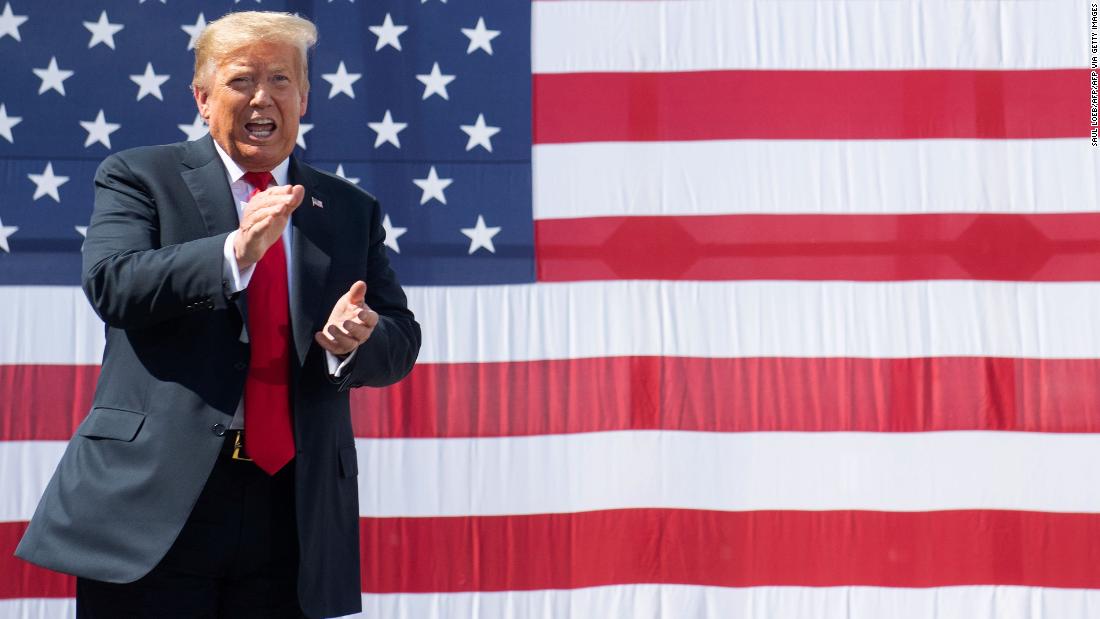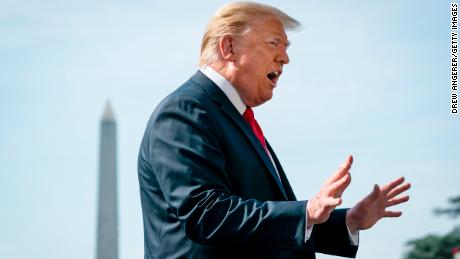The President, who wants a quick economic reboot to boost his reelection hopes, exacerbated a situation that is close to tipping out of control
More than 37,000 new cases of Covid-19 were reported on Thursday, according to Johns Hopkins University data. The numbers superseded the previous darkest day of the pandemic, on April 24. The new data suggests that the sacrifices made by tens of millions of Americans who stayed at home, that cost many of them their jobs, might have been in vain. It also suggest that the aggressive state re-openings championed by Trump, who wants a quick economic reboot to boost his reelection hopes, exacerbated a situation that now seems close to tipping out of control across a swathe of southern states.
A total of 30 states are now reporting a rise in new daily cases of the novel coronavirus while others keep setting new records in each 24-hour period. And while the President lives in a bubble of his own obsessive political feuds and the embrace of conservative media that rarely dwells on the virus, the reality of a pandemic that may still be in its early changes is beginning to squeeze in on his world.
Across the country, as California struggles through an awful time, Disneyland put back its plans to reopen, in a symbolic illustration of the plight of an entire state — and indeed a nation that has seen leisure and frivolity disappear amid the worst domestic crisis since the Second World War.
There are more signs that the rocket-like economic recovery that Trump has been projecting is not materializing either. Top White House economic adviser Larry Kudlow said Thursday that unemployment could dip below 10% by the end of the year, meaning that it would be still at an elevated level when Trump faces reelection in November. And US retail giant Macy’s announced it would cut around 3,900 jobs as part of a restructuring effort amid an economic crisis that Trump’s early denial about the pandemic and mismanagement of it when it arrived in the US may have exacerbated.
Yet on Thursday, Trump climbed aboard Air Force One for the third time in five days for a cross country trip — to swing state Wisconsin — that flouted his own government’s guidelines on the use of masks and social distancing, and that in itself was a massive deflection from the building national tragedy that the President appears determined to ignore since it contradicts his great comeback narrative he is determined to use for his reelection campaign.
At no time on Thursday did Trump model the use of a mask — despite it being a precaution scientists say could do the most to slow the spread of the disease, which is intensifying its first wave assault ahead of a feared second attack in the fall. But even in the friendliest possible territory — a Fox News town hall with Sean Hannity — members of the audience sat on stools that were spaced apart and did wear masks on the orders of the TV station.
The President, who has previously said the virus was fading away and dying out, got a predictably easy ride on the show, as he was teed up for his campaign lines on immigration, protecting statues that anti-racism protesters want to tear down and attacks on Democrats and presumptive nominee Joe Biden, as well as false claims about the dangers of fraud from mail-in balloting.
The President predicted that the US would have a vaccine for the coronavirus before the end of the year, in contravention of the advice of most scientific experts. And at times, he seemed to strike an almost valedictory note, as he made meandering arguments about the mental capacity of his rival.
“I mean, the man can’t speak,” Trump said. “And he’s going to be your president because some people don’t love me, maybe.”
Biden, who is seizing on Trump’s failures on the pandemic to try to oust him after a single term, earlier lambasted the President’s behavior.
“He’s like a child who can’t believe this has happened to him. All his whining and self-pity. Well, this pandemic didn’t happen to him. It happened to all of us. And his job isn’t to whine about it, his job is to do something about it. To lead,” Biden said.
Plight of Texas encapsulates growing national crisis
The increasing chasm between Trump’s version of America and the reality of a nation falling back into an exhausting fight with the disease after a hopeful period in early May and June raises the question of how long the President can go on ignoring the situation. This is especially the case when even his allies, like Texas Republican Gov. Greg Abbott, are now admitting they’re dealing with a serious problem. In places like Texas, filling hospital wards and intensive care units — that could in a few weeks, given the normal course of the illness, be expected to lead to higher death rates — contradict optimistic talk from politicians and especially Trump’s fictional narrative that the worst is past.
“It’s pretty dire,” Dr. Peter Hotez, professor and dean of the National School of Tropical Medicine at Texas’s Baylor College of Medicine, told CNN’s Jake Tapper.
“We’ve got an enormous amount of community transmission. If you look at the curve of the numbers going up, it’s following what we call an exponential curve, which is it looks initially flat, and then it accelerates very sharply, almost vertically. And that’s where we’re at right now,” Hotez added.
Abbott had hoped to pursue an opening plan that envisaged getting the state mostly back to normal by July 4.
“The last thing we want to do as a state is go backwards and close down businesses. This temporary pause will help our state corral the spread until we can safely enter the next phase of opening our state for business,” Abbott said.
The bad news that contradicts Trump’s rosy version of a post-Covid America is not confined to Texas. Arizona’s governor said Thursday the state’s reopening plans are now “on pause” as a result of a major spike in coronavirus cases. Gov. Doug Ducey, a Republican, said Arizona will not be rolling back its business reopening plans, but will be requiring businesses to follow social distancing rules that are still in effect. “If they choose not to, there will be accountability, and there will be enforcement.”
In California, Democratic Gov. Gavin Newsom warned he would slow the state’s opening if hospitals become strained as his state announced another 5,000 infections. In Ohio, Republican Gov. Mike DeWine implicitly rejected Trump’s rationale for rising infections. “We have increased testing, but we do not believe this increase in cases is completely due to testing,” DeWine said, confirming that hospitalizations are up.
Mississippi established its highest single-day increase of new coronavirus infections on Thursday. There are now at least 30 states reporting an increase in new cases in the past week. Of those states, 13% are reporting a 50% or greater increase.
‘I don’t think he’s going to change where he’s at on masks’
The worsening picture is not yet convincing Republican leaders to require their constituents to wear masks, which appears still to be a leap too far.
“I urge all Texans to do their part to help contain the spread by washing their hands regularly, wearing a mask, and practicing social distancing,” said Abbott, one of a number of Republican leaders urging people to wear masks but who won’t mandate the step, which some conservatives argue is an infringement on their personal rights, despite evidence that many people are ignoring medical advice.
Senate Majority Leader Mitch McConnell is another member of that group, even though he habitually wears a mask while navigating Capitol Hill. “I think that’s what people ought to do. And that’s what we’re doing in the Senate and what I’m counseling other people to do,” the Kentucky Republican told reporters Thursday.
Many Americans have an innate and genuine skepticism of government mandating that they do anything. That is why Trump could provide such a valuable role by demonstrating the use of masks. But the President, despite his legendary appeal to his base, often appears loath to use that political capital and convince his supporters to change their behavior.
One of Trump’s closest political friends, South Carolina Sen. Lindsey Graham, is not holding his breath for a change of heart on Trump’s part.
“Listen, I don’t think he’s going to change where he’s at on masks. But he might, I don’t know,” Graham said.
![]()




